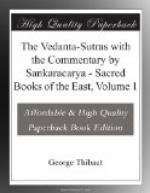in the passage, ‘These are the five persons of
Brahman’ (Ch. Up. III, 13, 6); and
another passage runs, ’Breath is father, breath
is mother,’ &c. (Ch. Up. VII, 15,
1). And, owing to the force of composition, there
is no objection to the compound being taken in its
settled conventional meaning[238].—But how
can the conventional meaning be had recourse to, if
there is no previous use of the word in that meaning?—That
may be done, we reply, just as in the case of udbhid
and similar words[239]. We often infer that a
word of unknown meaning refers to some known thing
because it is used in connexion with the latter.
So, for instance, in the case of the following words:
’He is to sacrifice with the udbhid; he cuts
the yupa; he makes the vedi.’ Analogously
we conclude that the term pa/nk/ajana/h/, which, from
the grammatical rule quoted, is known to be a name,
and which therefore demands a thing of which it is
the name, denotes the breath, the eye, and so on, which
are connected with it through their being mentioned
in a complementary passage.—Some commentators
explain the word pa/nk/ajana/h/ to mean the Gods,
the Fathers, the Gandharvas, the Asuras, and the Rakshas.
Others, again, think that the four castes together
with the Nishadas are meant. Again, some scriptural
passage (
Rig-veda Sa/m/h. VIII, 53, 7)
speaks of the tribe of ‘the five-people,’
meaning thereby the created beings in general; and
this latter explanation also might be applied to the
passage under discussion. The teacher (the Sutrakara),
on the other hand, aiming at showing that the passage
does not refer to the twenty-five categories of the
Sa@nkhyas, declares that on the ground of the complementary
passage breath, &c. have to be understood.
Well, let it then be granted that the five-people
mentioned in the Madhyandina-text are breath, &c.
since that text mentions food also (and so makes up
the number five). But how shall we interpret the
Ka/n/va-text which does not mention food (and thus
altogether speaks of four things only)?—To
this question the next Sutra replies.
13. In the case of (the text of) some (the Ka/n/vas)
where food is not mentioned, (the number five is made
full) by the light (mentioned in the preceding mantra).
The Ka/n/va-text, although not mentioning food, makes
up the full number five, by the light mentioned in
the mantra preceding that in which the five-people
are spoken of. That mantra describes the nature
of Brahman by saying, ’Him the gods worship
as the light of lights.’—If it be
asked how it is accounted for that the light mentioned
in both texts equally is in one text to be employed
for the explanation of the five-people, and not in
the other text; we reply that the reason lies in the
difference of the requirements. As the Madhyandinas
meet in one and the same mantra with breath and four
other entities enabling them to interpret the term,
‘the five-people,’ they are in no need
of the light mentioned in another mantra. The
Ka/n/vas, on the other hand, cannot do without the
light. The case is analogous to that of the Sho/d/a/s/in-cup,
which, according to different passages, is either to
be offered or not to be offered at the atiratra-sacrifice.




